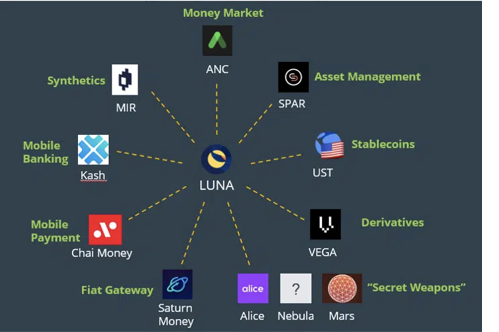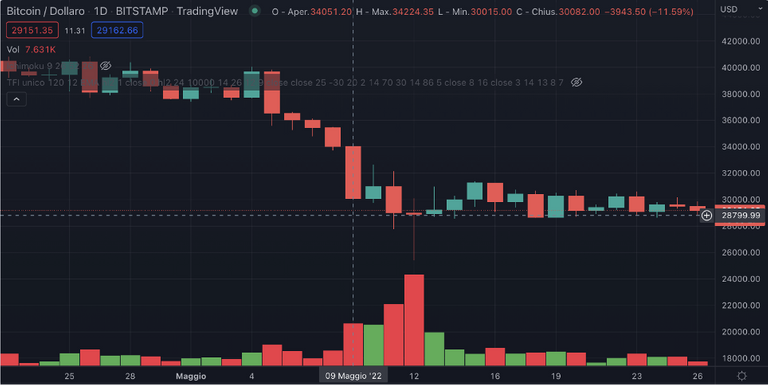Stablecoins: what are they, how they work, and their purposes and uses. Part #3
The Terra/Luna Case
Since May 7, the Terra and Anchor protocols have been experiencing terrible times.
The crash that happened to Terra is making the effects felt throughout the crypto world with serious financial consequences in everyone's pockets.
Not only that, but this destabilization is also fertile ground for detractors of the crypto world and big investors linked to traditional finance.
...After all, if you subvert the system, who guarantees the same gains but more importantly the decision-making power?
In the last few days, I have read everything about this affair with the most disparate opinions: the range starts from the denunciation that algorithmic Stablecoins (I wrote about them here and here are a real scam since they have no collateral, to calling the Anchor protocol a ponzi scheme good and proper, moving to personal attacks on Do Kwon who has been tacitly labeled as a scammer par excellence.
But let's start step by step: let's try to understand how the Terra/Luna protocol works, how it connects to Anchor, and then let's analyze the facts.
We will probably find out that something went wrong, or someone made it go wrong....
Follow along!
Terra/Luna - The Workings
The Terra/Luna ecosystem is an algorithmic, two-token seigniorage stable coin for maintaining the peg of its stable coins. The tokens are:
- Terra Stablecoin: (UST, KRT, EUT, etc.) - These are the stable each pegged to a different fiat currency;
- Luna: This is the native token on the Terra blockchain that is used to pay network fees for various transactions.
The way it works is simple: in exchange for LUNA tokens, UST tokens can be minted (for example, they could be EUTs).
Conversely, LUNA tokens can be minted in proportion to the UST token burn.
The stablecoin peg is maintained through the arbitrage principle.
When the peg to the UST dollar falls below $1, holders of UST tokens can burn them in exchange for LUNA tokens at the market price, creating a profit.
Likewise, when the peg to the dollar rises above $1, holders can exchange LUNA tokens to create USTs, consequently creating a profit.
This mechanism works since LUNA has its own value defined by the market and not by protocol.

As we saw in the previous article I brought up the example of Basis, which failed (also complicit in the hacking it had of 1 million BACs), it seemed that TERRA/LUNA had found the right balance to make the protocol solid and stable, flanking the possibility of token staking with the Anchor protocol enticed by a respectable APY (about 20 percent) and the other Mirror protocol, which is nothing but tokenization of real resources.
Not only that.
In addition to these possibilities, Terraform Labs founder and CEO Do Kwon has created reserves: with the Luna Foundation Guard.
This Foundation is tasked with protecting UST's peg.
LFG has (had) as reserves about $2.3 billion in BTC with the goal of reaching $10 billion in BTC.
This way, if the algorithm were to have flaws, however, the peg would be secured by collateral.
Let's try to understand: if the protocol showed no signs of breaking down until May 6 and the collateral is in place, how come all of a sudden all hell broke loose?
A bit of "chronicling" the death spiral
On Saturday, May 7, more than $2 billion in UST was removed from the Anchor Protocol and hundreds of millions were immediately sold.
This maneuver sent UST's peg plummeting to $0.91, at which point all traders aimed for the "hit": trade UST at $0.90 for Moon at $1 and I'll make up a nice 10% in a few minutes.
But they didn't do the math with the algorithm: you can burn "only" $100 million in UST per day to coin LUNA.
Hence a sipral of death was triggered that led to decreeing the end of the TERRA/LUNA ecosystem.
As written, the graphs confirm the situation.
Let us look at the graph below UST/USD:

The peg trend of UST is almost constant, in the jargon you would say it "lateralizes": right it is a stablecoin, the price must be constant.
Let's look at the volumes for a moment: we have a protocol intervention towards the end of February first days of March, then everything is back to normal: no price excursion and no correction by the algorithm.
Let's look at this graph of BTC/USDT:

As for the UST chart, nothing unusual, everything is within normal (if you can call it that) market movements.
Let's move on from May 6:
UST/USD chart:

As we can see from the volumes the "death spiral" started around May 5, obviously culminated, with the subsequent blockchain suspension, on May 12; also due to a general panic-sell.
Let's look at BTC/USD:

Again we find some decline on May 5, and thereafter volumes "bolted" until the 12th.
Coincidence?
Could be: one of the major stablecoins plummets and the whole crypto market suffers a general "stampede" induced by an uncertain future-why not?
Instead, let's try to analyze the charts according to what are the rumors debunked by the various stakeholders-BlackRock, Citadel and Gemini.
The rumors say that BlackRock, backed by Citadel borrowed 100,000 BTC from Gemini (for a countervalue of $3900 billion) of this 100,000 a 25 percent would be used to buy UST at a discounted price and then be immediately put back into the market, the remaining portion of BTC sold normally.
This would explain the spikes in volume on those days... Or rather it would explain the trigger on Saturday, May 7: the $2 billion USTs burned by the Anchor protocol.
However, a point needs to be made: BlackRock recently backed Circle Internet Financial Ltd. which is the issuer of another dollar-anchored stablecoin: it is currently the fourth largest cryptocurrency in terms of capitalization: we are very close to $50 billion.
Did he probably want to eliminate a viable competitor that had a volume of $14 billion in the Anchor protocol alone?
This is not known; what is known precisely is that all the actors have declared that they are uninvolved in the matter.
However, no one has shown their wallet transactions....
Conclusions
As a matter of fact, algorithmic stablecoins are to be treated with kid gloves as the protocols, no matter how well taken care of and as secure as possible, still cannot counter human cunning and intelligence.
Therefore, it is preferable to rely on stablecoins with underlying: token issuance is contingent on supply in fiat; in this way depeg is almost impossible.
Obviously, these ideas are mine and mine alone and do not express an opinion on the strong powers, although this affair honestly leaves me speechless
Posted Using LeoFinance Beta
Thanks to @gasaeightyfive @cribbio and @marcocasario for your reblog!